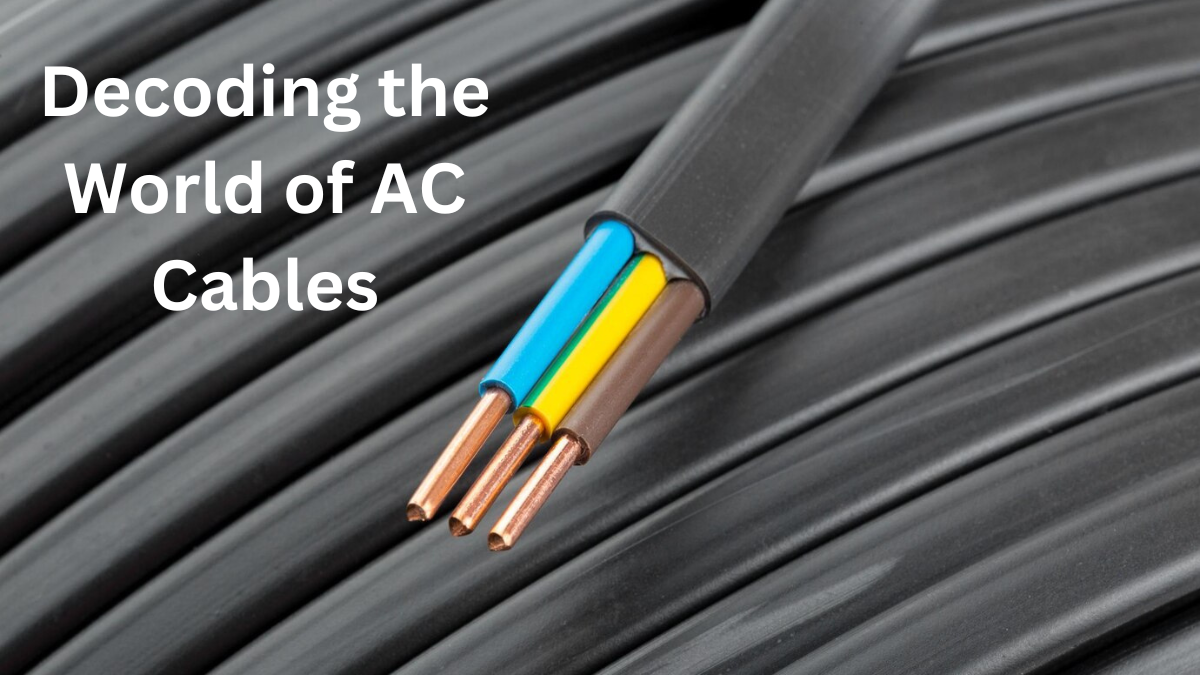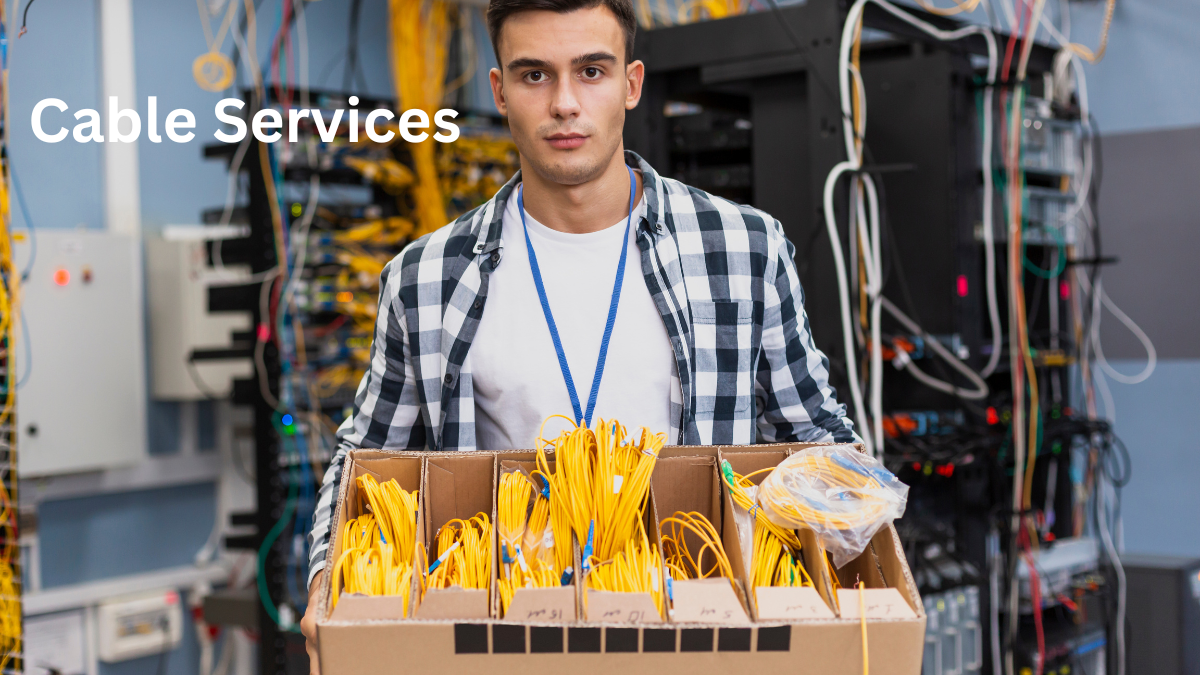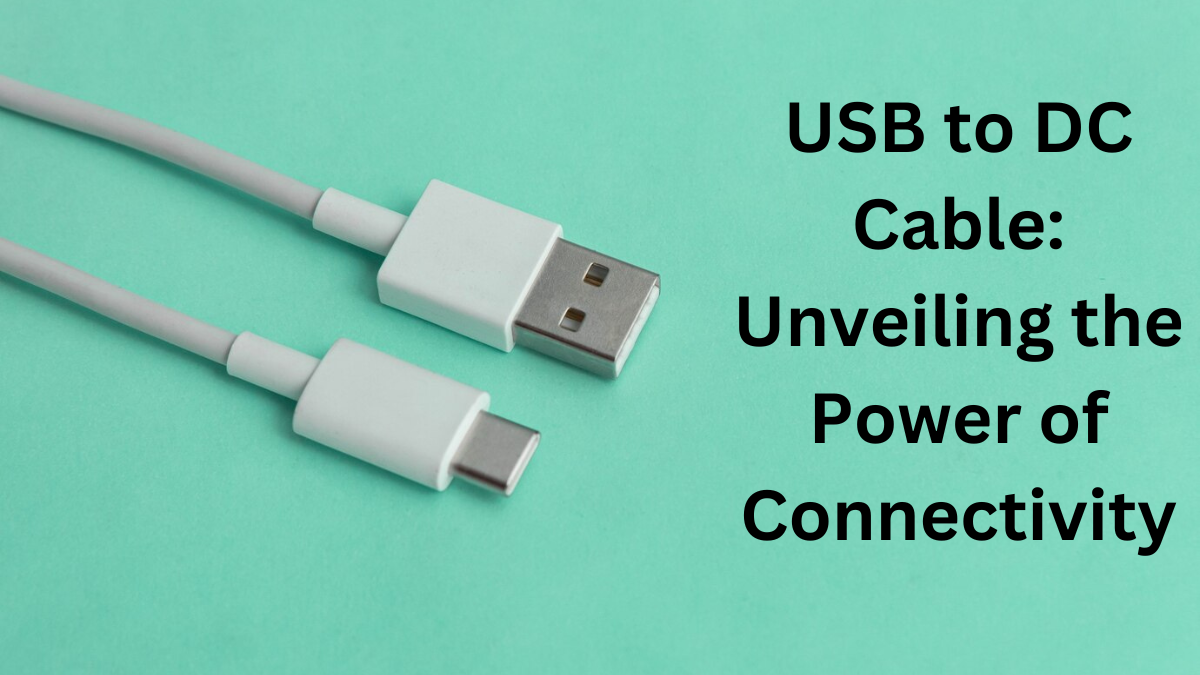Cables
Decoding the World of AC Cables

The unsung heroes that keep energy flowing smoothly in the fast-paced world of electricity and power distribution are AC cable. These cables, also known as alternating current cables, are the foundation of electrical systems because they provide dependable and efficient power transfer.
Introduction to AC Cables
Power cables, sometimes referred to as AC cables, are essential components of the electrical system. They play a vital role in the movement of electrical energy between locations. Unlike DC cables (Direct Current), AC cables are more versatile in their applications because they may change the direction of electric current flow.
Types of AC Cables
When exploring the world of AC cables, one comes across a range of varieties, each designed for a certain use. There are several possibilities, including shielded, unarmored, and armored cables. Extra protection is offered by armored wires, which protect against electromagnetic interference. The decision is based on the particular needs of the application.
Choosing the Right AC Cable
Carefully weighing variables including voltage, current, and ambient conditions is necessary when choosing the proper AC cable. It is essential to match cable specifications to application requirements to ensure maximum performance and safety.
Installation of AC Cables
AC cable installation calls for accuracy and attention to safety regulations. This section offers a detailed installation guide for AC cables with a focus on safety measures to prevent mishaps and guarantee durability.
Maintenance and Troubleshooting
Regular maintenance is necessary for AC cables to function at their best. This section provides helpful hints for preserving AC cables and resolving typical problems that could occur over time.
AC Cable vs. DC Cable: Key Differences
It is essential to comprehend the distinctions between AC and DC cables. This section explores the differences between the two and provides examples of situations when one kind could be better than the other.
Recent Technological Advances in AC Cables
Just as technology advances, so too do AC cords. Improvements in performance and efficiency are a result of material and design innovations. This section examines current developments in AC cable technology and how they affect different sectors.
Regulatory Standards for AC Cables
Respecting industry norms and guidelines is essential for dependability and safety. This section highlights how crucial it is to follow rules in order to guarantee that AC wires are operating properly.
Cost Considerations in AC Cable Selection
While quality is important, choosing AC cables also involves a lot of financial considerations. This section looks at the variables that affect AC cable prices and offers advice on how to strike a balance between price and quality.
Case Studies: Successful AC Cable Applications
Examples from everyday life demonstrate how well AC wires work in a variety of settings. These case studies provide insightful information and important takeaways from effectively installed AC cables.
Future Trends in AC Cable Technology
Exciting prospects await AC cable technology in the future. This section examines new developments in technology and trends that might influence the future of AC cables.
Environmental Impact of AC Cables
This section addresses the environmental impact of AC cables and looks at eco-friendly substitutes and methods in an era where people are becoming more conscious of the environment.
Common Myths About AC Cables
AC cable misconceptions are common. In order to dispel widespread misconceptions, this section clarifies the facts pertaining to AC wires.
Expert Recommendations for AC Cable Usage
Misconceptions about AC cables abound. This section aims to debunk common myths, providing clarity on the facts surrounding AC cables.
Conclusion
In summary, AC cables are the unsung heroes of power transmission—they quietly make it possible for electrical systems all around the world to operate. Making educated decisions is made easier for decision-makers when they are aware of the subtleties of AC cables, from kinds and installations to maintenance and upcoming trends.
Prepare to embrace the power of AC cables to ensure a dependable and effective energy flow in your projects.
FAQs (Frequently Asked Questions)
- What are the main types of AC cables?
- Armored, unarmored, and shielded cables are the main types of AC cables, each serving specific purposes.
- How do I choose the right AC cable for my application?
- To ensure that cable parameters meet application requirements, take into account variables like voltage, current, and environmental concerns.
- Are there eco-friendly alternatives to traditional AC cables?
- Yes, under the part on the effects of AC wires on the environment, the paper discusses eco-friendly options and methods.
- What are the key differences between AC and DC cables?
- The basic distinctions between AC and DC wires are explained in great depth in this article.
- How often should I perform maintenance on AC cables?
- The maintenance area gives advice on how often to do maintenance as well as insights on how to operate at your best.
Cables
The Evolution of Cable Services: From Analog to Digital

Cable Services The world of television has undergone a remarkable evolution, transforming from the days of analog cable to the digital age we live in today. This journey has not only shaped the way we consume content but has also presented challenges and opportunities for the cable service industry. In this article, we’ll delve into the fascinating evolution of cable services, exploring the shifts from analog to digital and the impact of technological advancements.
I. Introduction
A. Definition of CableServices
Cableservices refer to the transmission of television programming through coaxial cables or fiber optics, delivering a wide range of channels to viewers’ homes.
B. Significance of Cable Evolution
Understanding the evolution of cableservices is crucial for grasping the dynamics of the television industry and the changing preferences of viewers.
C. Purpose of the Article
This article aims to provide a comprehensive overview of the evolution of cableservices, focusing on key milestones, technological advancements, and the industry’s response to changing consumer behavior.
II. The Analog Era
A. Emergence of Analog Cable
In the early days, analog cable was the primary mode of transmitting television signals. This involved the use of analog signals over coaxial cables, allowing households to access a variety of channels.
B. Limited Channels and Quality
However, analog cable had its limitations. The number of available channels was restricted, and the picture and sound quality were often subpar compared to today’s standards.
C. Viewer Experience in Analog
Viewers in the analog era faced challenges such as signal interference, snowy screens, and limited programming options. The experience was a far cry from the seamless viewing we enjoy today.
III. Transition to Digital
A. Digital Cable Introduction
The Transition to Digital CableServices The world of television has undergone a remarkable evolution, transforming from the days of analog cable to the digital age marking a significant turning point. Digital signals replaced analog, offering clearer and more reliable transmission.
B. Benefits of Digital Cable
Digital cable brought several benefits, including improved picture and sound quality and the ability to transmit more channels through the same infrastructure.
C. Improved Picture and Sound Quality
Viewers experienced a noticeable enhancement in their viewing experience, with sharper images, clearer sound, and a broader array of channels to choose from.
IV. Interactive Features
A. On-Demand Services
One of the groundbreaking features of digital cable was the introduction of on-demand services. Viewers could now choose when and what to watch, revolutionizing the traditional TV schedule.
B. Interactive Program Guides
Digital cable also introduced interactive program guides, making it easier for viewers to navigate through channels and find their favorite shows with just a few clicks.
C. Enhanced User Experience
These interactive features significantly enhanced the user experience, providing more control and convenience for television consumers.
V. High-Definition Revolution
A. Introduction of HD Channels
As technology continued to advance, high-definition (HD) channels became a standard offering. This marked a revolution in television, providing unprecedented clarity and detail.
B. Impact on Viewing Experience
The introduction of HD channels elevated the viewing experience, making it more immersive and appealing. Viewers could now enjoy content with cinematic quality from the comfort of their homes.
C. Technological Advancements
Technological advancements in cable services continued, with innovations like DVR (Digital Video Recorder) allowing viewers to record and revisit their favorite programs at their convenience.
VI. Rise of Streaming Services
A. Streaming Platforms’ Influence
The rise of streaming services, driven by platforms like Netflix and Hulu, had a profound impact on how people consumed content. The convenience of on-demand streaming posed a challenge to traditional cable services.
B. Shift in Consumer Behavior
Consumers increasingly embraced the flexibility and variety offered by streaming platforms, leading to a shift in their viewing habits and a decline in traditional cable subscriptions.
C. Cable Services’ Response
To stay relevant, cableservices adapted by offering their streaming options and integrating internet services into their packages. This hybrid approach aimed to cater to the changing needs of consumers.
VII. Challenges Faced
A. Cord-Cutting Trend
The emergence of the cord-cutting trend, where viewers abandoned traditional cable subscriptions in favor of streaming services, posed a significant challenge for cable providers.
B. Competition with Streaming
Cable services found themselves in fierce competition with streaming platforms, requiring them to innovate and diversify their offerings to retain and attract viewers.
C. Technological Obsolescence
The fear of technological obsolescence loomed, prompting cable providers to invest in cutting-edge technologies and explore new ways to deliver content.
VIII. The Future of Cable Services
A. Integration with Internet Services
The future of cable services lies in seamless integration with internet services. Cable providers are exploring ways to offer bundled packages that combine traditional TV with high-speed internet.
B. Technological Innovations
Continued technological innovations, such as 5G connectivity and virtual reality, will likely shape the future of cable services, offering more immersive and interactive viewing experiences.
C. Personalized Content Delivery
As consumer preferences become more personalized, cable services are expected to focus on delivering tailored content, utilizing data analytics to understand and anticipate viewer choices.
IX. Impact on Industry Players
A. Cable Providers’ Adaptation
Major cable providers have adapted to the evolving landscape by diversifying their services. Some have even partnered with streaming platforms to offer bundled packages, catering to a broader audience.
B. Role of Regulatory Bodies
Regulatory bodies play a crucial role in shaping the industry. As cableservices evolve, regulatory frameworks may need to adapt to ensure fair competition and consumer protection.
C. Consumer Expectations
Understanding and meeting consumer expectations are paramount. Cable providers need to stay attuned to the changing demands of viewers and offer services that align with evolving preferences.
X. Conclusion
A. Recap of Cable Evolution
In conclusion, the evolution of cableservices from analog to digital has been a transformative journey. Technological advancements, changes in consumer behavior, and the rise of streaming services have all contributed to shaping the industry.
B. Prospects for the Future
The future holds exciting prospects for cable services, with a focus on integration, technological innovations, and personalized content delivery. Adapting to these trends will be crucial for the industry’s continued success.
C. The Ongoing Evolution
The evolution of cableservices is ongoing, and the industry must remain agile and responsive to stay relevant in an ever-changing media landscape.
FAQs
- Are analog cable services still available today?
- While analog cable services are rare, some providers may offer them in specific regions. However, digital cable is the standard in most areas.
- How has the rise of streaming services affected cable providers?
- Streaming services have led to increased competition, prompting cable providers to innovate and offer hybrid solutions that include both traditional cable and streaming options.
- What role do regulatory bodies play in the cable industry’s evolution?
- Regulatory bodies help shape industry practices, ensuring fair competition and consumer protection as cable services adapt to new technologies and consumer preferences.
- What are some upcoming technological innovations in cableservices?
- Cableservices are exploring innovations such as 5G connectivity and virtual reality to enhance the viewing experience and stay competitive in the evolving media landscape.
- How can cable providers meet the personalized content demands of viewers?
- Cable providers can leverage data analytics to understand viewer preferences and offer personalized content recommendations, creating a more tailored and engaging experience.
SEE ALSO: CABLE
- Cable providers can leverage data analytics to understand viewer preferences and offer personalized content recommendations, creating a more tailored and engaging experience.
Cables
USB to DC Cable: Unveiling the Power of Connectivity

USB to DC cable Nowadays, with all the high-tech devices we have, USB-to-DC connections are the standard way to power and charge gadgets because batteries are constantly needed. Let’s look at the intricacies of these cables, their functions, their applications, and some tips for making the most of them.
Understanding USB to DC Cables
USB to DC cables, sometimes called Universal Serial Bus to Direct Current connections, are connectors that go from USB ports to devices that require direct current power.
They are essential in our everyday lives since they are available in a variety of sorts, each intended for a certain purpose.
How USB to DC Cables Work
Fundamentally, these cables ensure that electronics like smartphones, cameras, and other devices are compatible by converting the alternating current (AC) from USB ports into direct current (DC). The technological specifics include a procedure that is both intricate and effective, enabling smooth power transfer.
Common Applications
The numerous uses for USB to DC connections demonstrate their adaptability. In today’s linked digital world, cables are indispensable for everything from charging your smartphone to connecting peripherals like printers and powering necessary electrical devices.
Advantages of USB to DC Cables
There are several benefits to using USB to DC connections. Consumers looking for cost-effective, versatile power solutions are the go-to option because of their affordability. These cables offer a dependable power supply while you’re at home or on the move.
Choosing the Right USB to DC Cable
When choosing the right cable for your device, it’s important to take connection types, voltage, and amperage into account—knowing if your device and the cable are compatible guarantees top performance and guards against any harm.
Tips for Proper Usage
A few simple guidelines must be followed if you want to get the most out of your USB to DC cable. Maintaining a longer lifespan and effective operation may be achieved by avoiding harsh environments, safeguarding connections, and utilizing authorized cables.
USB to DC Cable vs. Other Charging Options
USB to DC cables are more versatile and compatible than traditional charging methods, which makes them a more practical and effective power source for consumers.
Future Developments in USB Technology
USB technology is evolving along with technology. Remaining ahead of the curve in the always-changing world of electronic communication requires keeping a watch on new developments and possible advancements in USB to DC cable technology.
User Reviews and Experiences
User experiences from real-world situations offer important information about how well USB-to-DC connections work. Positive evaluations emphasize their dependability, and resolving any issues or problems helps to raise customer satisfaction levels all around.
Safety Concerns and Best Practices
It is critical to address safety risks related to USB to DC cords. Encouraging users to follow standard practices, such not overloading circuits and utilizing high-quality cords, makes charging safer and more secure.
Environmental Impact
It’s critical to take the environment into account while choosing technological equipment. Talking about how environmentally friendly USB to DC connections are and promoting appropriate disposal techniques are in keeping with the increased focus on sustainability.
Conclusion
In summary, USB to DC connections serve as the foundation of connectivity and provide a smooth power option for our electronic gadgets. In the fast-paced digital era, their efficiency, ease, and variety make them vital. USB to DC connections will probably become even more important as technology develops and shapes our linked future.
FAQs
-
Are all USB to DC cables the same?
- No, there are several varieties and standards of USB to DC cables. Selecting the appropriate cable for your particular device is essential.
-
Can I use a USB to DC cable for fast charging?
- Depending on the device being charged and the cable’s characteristics, certain USB to DC cables can offer rapid charging.
-
What should I do if my USB to DC cable is not working?
- To troubleshoot, please make sure that all connections are made correctly, inspect the device carefully for any obvious damage, and try using an alternative USB port or power outlet.
-
Are USB to DC cables environmentally friendly?
- Compared to conventional chargers, USB to DC cables can be more environmentally friendly, but it’s important to dispose of them properly.
-
Can I use a USB to DC cable to power any electronic device?
- Even if the cable is flexible, it’s important to make sure it works with your particular equipment to prevent harm.
Cables
Hathway Cable Share Price: Current Trends and Analysis

Hathway Cable, a prominent player in the cable and broadband industry, has garnered attention due to its share price dynamics. This article delves into the current trends and factors influencing Hathway Cable’s share price.
Company Background
History and Evolution
Hathway Cable’s inception, growth trajectory, and pivotal milestones contribute to understanding its current market standing.
Share Price History
Past Performance Analysis
Examining Hathway Cable’s historical share prices, analyzing trends, peaks, troughs, and influential events that shaped its trajectory.
Current Trends
Factors Affecting Share Price
Exploration of present-day elements impacting Hathway Cable’s share price, including market conditions, industry shifts, and company-specific factors.
Financial Analysis
Revenue, Profit, and Growth Analysis
An in-depth evaluation of Hathway Cable’s financial metrics, revenue streams, profitability, and growth patterns over recent quarters or years.
Competitor Comparison
Market Positioning and Comparison
Comparative analysis with competitors, highlighting Hathway Cable’s strengths, weaknesses, and market differentiation.
Future Prospects
Growth Potential and Predictions
Insights into the company’s future growth prospects, forecasts, and expert opinions on its potential trajectory.
Conclusion
In summary, Hathway Cable’s share price is influenced by a multitude of factors, encompassing its history, financial performance, industry trends, and market positioning.
FAQs about Hathway Cable
- What factors drive Hathway Cable’s share price?
- The share price is influenced by industry trends, financial performance, and market perception.
- How does Hathway Cable compare to its competitors?
- Hathway’s market position, strengths, and weaknesses can be better understood through comparative analysis.
- Is Hathway Cable’s future promising?
- Prospects depend on market conditions, strategic decisions, and technological advancements.
- Why is understanding share price history important?
- Historical trends offer insights into past performance, aiding in predicting potential future movements.
- Where can I find more information about Hathway Cable’s financials?
- Official reports, investor presentations, and financial news platforms provide comprehensive details.
Get Access Now: https://bit.ly/J_Umma
-

 Fashion6 months ago
Fashion6 months agoλιβαισ: An Ageless Tradition of Denim and Fine Handicraft
-

 Lifestyle6 months ago
Lifestyle6 months agoIlikecomox: A Journey of Discovery
-

 Health5 months ago
Health5 months agoWell Health how to Build Muscle and Boost Your Strength
-

 Technology4 months ago
Technology4 months agoA Comprehensive Guide to the Meaning and Significance of FTMÇ·
-

 Health6 months ago
Health6 months agoHow to Build Muscle with WellHealth: A Comprehensive Guide
-

 Technology6 months ago
Technology6 months agoPixwox: Unleashing the Magic of Digital Art and Creativity
-

 Business6 months ago
Business6 months agoWells Fargo login Online Banking
-

 Technology6 months ago
Technology6 months agoExploring the Importance of Fidelity in Relationships
